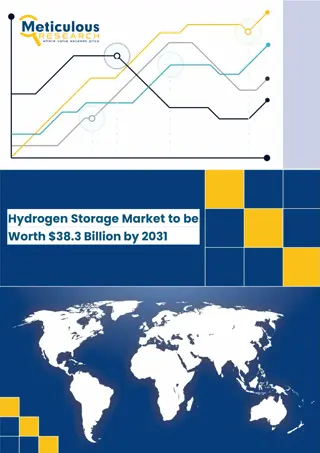Understanding Storage Devices: Hard Disks and Solid-State Drives
This informative content delves into the intricacies of storage devices, specifically hard disk drives (HDDs) and solid-state drives (SSDs). It covers the mechanics of HDDs, including seek time and rotational latency, and explores the structure and operations of SSDs, highlighting the differences in data storage and access mechanisms. The discussion also touches on the advantages and challenges posed by these two types of storage technologies.
Download Presentation

Please find below an Image/Link to download the presentation.
The content on the website is provided AS IS for your information and personal use only. It may not be sold, licensed, or shared on other websites without obtaining consent from the author. Download presentation by click this link. If you encounter any issues during the download, it is possible that the publisher has removed the file from their server.
E N D
Presentation Transcript
Storage Devices CS 161: Lecture 11 3/21/17
Spindle R/W heads Platter
Track Cylinder Sector Cylinder group
Accessing Data On A Hard Disk Access time is governed by several mechanical latencies Seek time: Moving the disk head to the right track Laptop/desktop drives have average seek times of 8 15ms High-end server drives have average seek times of 4ms Rotational latency: Moving the target sector under the disk head Dependent on the revolutions-per-minute (RPM) of the drive RPMs between 5400 7200 typical for laptop and desktop drives; server drives can go up to 15,000 So, average rotational latencies are 5.56 4.17 ms for laptop/desktop drives, 2 ms for high-end server drive If you want to read or write an entire cylinder group, you just have to pay the seek cost, and then you can read/write the cylinder group as the disk rotates
Your Hard Disk Is Sealed To Prevent Disk Head Tragedies [Courtesy of our friends at Seagate]
Solid-state Storage Devices (SSDs) Unlike hard drives, SSDs have no mechanical parts SSDs use transistors (just like DRAM), but SSD data persists when the power goes out NAND-based flash is the most popular technology, so we ll focus on it High-level takeaways 1. SSDs have a higher $/bit than hard drives, but better performance (no mechanical delays!) 2. SSDs handle writes in a strange way; this has implications for file system design
Solid-state Storage Devices (SSDs) An SSD contains blocks made of pages A page is a few KB in size (e.g., 4 KB) A block contains several pages, is usually 128 KB or 256 KB . . . . . . Page 0 1 2 3 4 5 6 7 8 9 11 10 Block 0 1 2 To write a single page, YOU MUST ERASE THE ENTIRE BLOCK FIRST A block is likely to fail after a certain number of erases (~1000 for slowest-but-highest-density flash, ~100,000 for fastest-but- lowest-density flash)
SSD Operations (Latency) Read a page: Retrieve contents of entire page (e.g., 4 KB) Cost is 25 75 microseconds Cost is independent of page number, prior request offsets Erase a block: Resets each page in the block to all 1s Cost is 1.5 4.5 milliseconds Much more expensive than reading! Allows each page to be written Program (i.e., write) a page: Change selected 1s to 0s Cost is 200 1400 microseconds Faster than erasing a block, but slower than reading a page Hard disk: 4 15ms avg. seek latency 2 6ms avg. rotational latency
Block Page 10011110 00100010 01101101 11010011 To write the first page, we must first erase the entire block 11111111 11111111 11111111 11111111 Now we can write the first page . . . . . . but what if we needed the data in the other three pages? 00110011 11111111 11111111 11111111
Flash Translation Layer (FTL) Goal 1: Translate reads/writes to logical blocks into reads/erases/programs on physical pages+blocks Allows SSDs to export the simple block interface that hard disks have traditionally exported Hides write-induced copying and garbage collection from applications Goal 2: Reduce write amplification (i.e., the amount of extra copying needed to deal with block-level erases) Goal 3: Implement wear leveling (i.e., distribute writes equally to all blocks, to avoid fast failures of a hot block) FTL is typically implemented in hardware in the SSD, but is implemented in software for some SSDs
FTL Approach #1: Direct Mapping Have a 1-1 correspondence between logical pages and physical pages Logical pages Physical pages Reading a page is straightforward Writing a page is trickier: Read the entire physical block into memory Update the relevant page in the in-memory block Erase the entire physical block Program the entire physical block using the new block value
Sadness #1: Write amplification Writing a single page requires reading and writing an entire block Sadness #2: Poor reliability If the same logical block is repeatedly written, its physical block will quickly fail Particularly unfortunate for logical metadata blocks
FTL Approach #2: Log-based mapping Basic idea: Treat the physical blocks like a log Send data in each page-to-write to the end of the log Maintain a mapping between logical pages and the corresponding physical pages in the SSD Logical pages 0 1 2 3 4 5 6 7 8 9 10 11 . . . . . . Page 0 1 2 3 4 5 6 7 8 9 10 11 Block 0 1 2
Logical-to-physical map Log head Uninitialized . . . . . . Valid Page 0 1 2 3 4 5 6 7 8 9 10 11 Block 0 1 2
write(page=92, data=w0) erase(block0) program(page0, w0) Logical-to-physical map 92 --> 0 logHead++ Log head Log head Uninitialized . . . . . . 1* w0 1* 1* 1* Valid Page 0 1 2 3 4 5 6 7 8 9 10 11 Block 0 1 2
write(page=92, data=w0) erase(block0) program(page0, w0) Logical-to-physical map 92 --> 0 17 --> 1 logHead++ write(page=17, data=w1) program(page1, w1) logHead++ Log head Log head Uninitialized . . . . . . w0 1* 1* w1 1* Valid Page 0 1 2 3 4 5 6 7 8 9 10 11 Block 0 1 2
write(page=92, data=w0) erase(block0) program(page0, w0) Logical-to-physical map 92 --> 0 17 --> 1 logHead++ write(page=17, data=w1) program(page1, w1) logHead++ Advantages w.r.t. direct mapping Avoids expensive read-modify- write behavior Better wear levelling: writes get spread across pages, even if there is spatial locality in writes at logical level Log head Uninitialized . . . . . . w0 w1 1* 1* Valid Page 0 1 2 3 4 5 6 7 8 9 10 11 Block 0 1 2
write(page=92, data=w4) erase(block1) program(page4, w4) Logical-to-physical map 92 --> 0 17 --> 1 33 --> 2 68 --> 3 92 --> 4 logHead++ Garbage version of logical block 92! Log head Log head Uninitialized . . . . . . 1* w4 w0 w1 w2 w3 1* 1* 1* Valid Page 0 1 2 3 4 5 6 7 8 9 10 11 Block 0 1 2
Logical-to-physical map 92 --> 0 17 --> 1 33 --> 2 68 --> 3 At some point, FTL must: Read all pages in physical block 0 Write out the second, third, and fourth pages to the end of the log Update logical-to-physical map 92 --> 4 Garbage version of logical block 92! Log head Uninitialized . . . . . . w4 w0 w1 w2 w3 1* 1* 1* Valid Page 0 1 2 3 4 5 6 7 8 9 10 11 Block 0 1 2
Trash Day Is The Worst Day Garbage collection requires extra read+write traffic Overprovisioning makes GC less painful SSD exposes a logical page space that is smaller than the physical page space By keeping extra, hidden pages around, the SSD tries to defer GC to a background task (thus removing GC from critical path of a write) SSD will occasionally shuffle live (i.e., non- garbage) blocks that never get overwritten Enforces wear levelling
SSDs versus Hard Drives (Throughput) Random Reads Writes (MB/s) (MB/s) Sequential Reads Writes (MB/s) (MB/s) Device Samsung 840 Pro SSD Seagate 600 SSD Intel 335 SSD 103 287 421 384 84 252 424 374 39 222 344 354 2 2 223 223 Seagate Savio 15K.3 HD Dollars per storage bit: Hard drives are 10x cheaper! Source: Flash-based SSDs chapter of Operating Systems: Three Easy Pieces by the Arpaci-Dusseaus.























